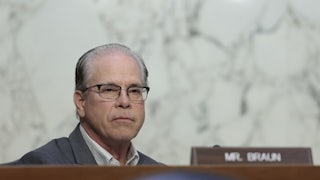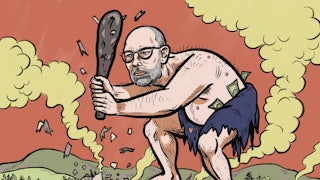Politico confirmed on Monday night what was clear from oral arguments in December as well as from a half-century of conservative legal activism: Roe v. Wade is poised to fall in the next two months. The news organization published a 98-page draft opinion written by Justice Samuel Alito that would overturn both Roe and Planned Parenthood v. Casey, the 1992 case that upheld it, if issued in the court’s name. Politico also reported that five conservative justices have voted to overturn Roe in conference, with Chief Justice John Roberts’s sixth vote up in the air as of last week.
“We hold that Roe and Casey must be overruled,” Alito declared in his draft of the court’s ruling in Dobbs v. Jackson Women’s Health Organization. “The Constitution makes no reference to abortion, and no such right is implicitly protected by any constitutional provision, including the one on which the defenders of Roe and Casey now chiefly rely—the Due Process Clause of the Fourteenth Amendment.” Alito added that it was “time to heed the Constitution and return the issue of abortion to the people’s elected representatives.”
There was no real doubt that the draft was authentic, but the court nonetheless confirmed it as genuine in a rare statement on Tuesday. “To the extent that this betrayal of the confidences of the Court was intended to undermine the integrity of our operations, it will not succeed,” Chief Justice John Roberts said in a statement. “The work of the court will not be affected in any way.” He also said that the “singular and egregious breach” of the court’s trust would be investigated by the Supreme Court’s marshal.
The court said that the ruling “does not represent a decision by the court or the final position of any member on the issues in the case.” Indeed, justices routinely tweak their opinions up until the final moment, and majorities that emerge during the first vote after oral arguments can change while the opinions are drafted. The Supreme Court initially voted 5–3 to jail the boxer Muhammad Ali when it heard a case about his conscientious-objector status during the Vietnam War draft in 1971, then issued an 8–0 ruling in his favor after, among other things, one of the justices reportedly read Malcolm X’s autobiography. Nothing is final at the high court until it is actually published, and it is still theoretically possible that Roe survives in some form by the end of the court’s term in June.
None of that should give abortion rights supporters much hope. I wrote after oral arguments in December that there appeared to be at least five votes to overturn Roe and Casey, and almost no legal experts or court-watchers anywhere else thought that the court would do anything else. Conservatives have spent decades organizing a movement to place at least five justices on the court who would reshape American constitutional law in their own image, with the overturning of Roe and Casey at its center. This is what they fought so hard for. I’d be foolish to say that it’s impossible that Roe survives Dobbs, but it would be the greatest surprise in American legal history if it does.
No one needs a crystal ball to predict some of what will happen after the court overturns Roe. The Guttmacher Institute, a research organization that focuses on abortion rights, estimated that 22 states already have laws that would criminalize or ban abortion if the Supreme Court steps aside. Some of these laws are pre-Roe statutes that were never taken off the books; others are so-called “trigger laws” that only go into effect if the court overturns Roe. Another half-dozen states where Republicans have legislative majorities could take further action now or when the court issues the decision.
What this would mean for the actual prevalence of abortion is unclear. The New York Times reported in March that a University of Texas study had found that the state’s overall rate of abortion hadn’t dropped as precipitously as expected after the state’s near-total ban took effect last fall. Researchers discovered that many women instead obtained one by traveling out of state to somewhere where it was still legal or by using abortion pills that they obtained online. While anti-abortion states can’t do much about the former, Texas lawmakers have tried to do something about the latter with little success. Abortion rights advocates often note that those with means will always be able to obtain the procedure and that the effects of such bans largely fall on women without the resources or connections to overcome them.
Beyond the immediate implications for Roe and access to abortion itself, a few things about Alito’s draft opinion stand out. One is his discussion of other rights protected by past Supreme Court rulings that aren’t spelled out explicitly by the Constitution. Alito discussed them in reference to Casey, the 1992 case that affirmed and rewrote Roe. A key question about the court’s ruling in Dobbs is whether it will throw a much broader swath of its rulings into question. Alito wrote, “Nor does the right to obtain an abortion have a sound basis in precedent,” noting that Casey “relied on cases involving the right to marry a person of a different race,” “the right to marry while in prison,” “the right to obtain contraceptives,” “the right to reside with relatives,” “the right to make decisions about the education of one’s children,” “the right not to be sterilized without consent,” and “the right in certain circumstances not to undergo involuntary surgery, forced administration of drugs, or other substantially similar procedures.” He added that “the respondents and the Solicitor General also rely on post-Casey decisions like Lawrence v. Texas,” which overturned laws criminalizing same-sex relationships, as well as the marriage-equality ruling Obergefell v. Hodges.
“These attempts to justify abortion through appeals to a broader right to autonomy and to define one’s ‘concept of existence’ prove too much,” Alito wrote, quoting from Casey. “Those criteria, at a high level of generality, could license fundamental rights to illicit drug use, prostitution, and the like. None of these rights has any claim to being deeply rooted in history.” Hopefully the final opinion makes clearer what “these rights” refers to, because it could conceivably be read as referring to the longer list of rights instead of the “right to illicit drug use” and so on.
In his next paragraph, Alito tried to suggest that the court wasn’t calling the longer list of rights into doubt. He wrote that “none of the other decisions cited by Roe and Casey involved the critical moral question posed by abortion,” which he described as the destruction of potential or actual human life. “They do not support the right to obtain an abortion, and by the same token, our conclusion that the Constitution does not confer such a right does not undermine them in any way,” Alito declared.
That assurance would be more comforting if Alito himself had not joined an opinion by Justice Clarence Thomas in a 2020 case that suggested revisiting Obergefell, the 2015 case that expanded the right to marriage to same-sex couples. “By choosing to privilege a novel constitutional right over the religious liberty interests explicitly protected in the First Amendment, and by doing so undemocratically, the court has created a problem that only it can fix,” Thomas wrote with Alito’s support. The two justices did not specify what that “fix” would be.
It would also be more comforting if Republican senators had not spent Judge Ketanji Brown Jackson’s confirmation hearing denigrating cases like Obergefell and Griswold v. Connecticut, which protects married couples’ right to purchase contraception. Texas Senator John Cornyn denounced Obergefell while questioning Jackson about unenumerated rights, while Indiana Senator Mike Braun even suggested in a conference call with reporters that overturning Roe v. Wade could lead to the overturning of Loving v. Virginia, the 1967 case that struck down state laws banning interracial marriages. “I think that that’s something that if you’re not wanting the Supreme Court to weigh in on issues like that, you’re not going to be able to have your cake and eat it too,” he told the reporters. (Braun later distanced himself from that assertion.)
Again, Republicans and the conservative legal movement have a vision of the American constitutional order that is clearly at odds with the one that most Americans now live under, and they will likely pursue the same tactics that worked against Roe to achieve it. Alito’s draft tried to stem the inevitable tide of post-Roe litigation: “To ensure that our decision is not misunderstood or mischaracterized, we emphasize that our decision concerns the constitutional right to abortion and no other right. Nothing in this opinion should be understood to cast doubt on precedents that do not concern abortion.” But that will probably not be enough to dissuade conservative legal activists from trying.
Much of Alito’s draft focused on the court’s traditional respect for its previous decisions, which he argued does not apply to Roe and Casey. Much of his argument here is no different from similar critiques of those decisions made over the years. What stands out here is a brief aside he made on Roe’s viability framework, where he touches upon the question of when a fetus becomes a person. He noted that some philosophers and ethicists “have argued that a fetus should not be entitled to legal protection until it acquires the characteristics that they regard as defining what it means to be a ‘person.’”
“By this logic, it would be an open question whether even born individuals, including young children or those afflicted with certain developmental or medical conditions, merit protection as ‘persons,’” he continued. “But if one takes the view that ‘personhood’ begins when a certain attribute or combination of attributes is acquired, it is very hard to see why viability should mark the point where ‘personhood’ begins.” Some anti-abortion activists and scholars have called on the courts to recognize fetuses as legal persons from the moment of conception under the Fourteenth Amendment, which could, among other things, make abortion illegal under state murder laws.
Alito apparently recognized the implications of some of his reasoning while writing the opinion. “One may disagree with this belief (and our decision is not based on any view about whether a state should regard prenatal life as having rights or legally cognizable interests), but even Roe and Casey did not question the good faith of abortion opponents,” he wrote. If anti-abortion litigants pursue that argument after Dobbs, they will likely anchor it in Alito’s side arguments here.
It is slightly amusing that the court felt the need to confirm that the draft opinion was authentic, because no court-watcher who reads it could think that anyone but Samuel Alito wrote it. It bears all the hallmarks of his usual haughty and uncharitable writing style. He quotes past criticism of Roe’s reasoning from liberal and not-conservative law professors like Lawrence Tribe, Mark Tushnet, and John Hart Ely in what reads like an attempt to own the libs. Ruth Bader Ginsburg’s past criticism of Roe, which she claimed had eclipsed a grassroots pro-abortion movement that might have achieved the same end with less national rancor, is sprinkled in for good measure.
If Roberts was not part of the initial majority, then under the court’s internal rules it would fall to the most senior member of the majority to assign the opinion to a justice. It’s unclear why Justice Clarence Thomas did not assign such a historic ruling to himself. But his choice of Alito may ensure that it carries the unmistakable air of culture-war pugilism. Alito even went out of his way to mock some of the arguments raised by a single friend-of-the-court brief that argued that some nineteenth-century anti-abortion laws stemmed from desires to increase the Protestant birth rate. “Are we to believe that the hundreds of lawmakers whose votes were needed to enact these laws were motivated by hostility to Catholics and women?” he snarked. Most of the other justices would resist the urge to go after weaker peripheral arguments in major cases, especially when speaking in the court’s institutional voice. While his draft opinion speaks of merely returning abortion to the democratic process and healing a bitter national feud, the rest of its tone and tenor confirms its combative intent.
On the leak itself, there isn’t much to say—and there is a lot to speculate about. The Supreme Court has never been totally leak-proof: Rumors about Gorsuch’s vote in Bostock v. Clayton County made their way to conservative media outlets a few months before the ruling came down, and Time magazine even reported the outcome of Roe v. Wade on the eve of the decision. But a full draft opinion has never leaked to the press in the modern history of the court, and the reaction inside the marble palace will likely be thermonuclear.
Draft opinions typically circulate among the nine justices, and each justice’s four or five clerks likely had access to it as well, especially if their justice is writing a concurring opinion or a dissent. That gives us a minimum of 50 people who could be responsible. When the Roe outcome leaked, Chief Justice Warren Burger initially wanted to have the FBI administer lie detector tests to each of the clerks to find out who was responsible. Roberts may not go that far, but he will likely try his best to find out who did it.
Among most conservatives and many liberals, the default assumption is that a liberal clerk sent the draft to Politico. “By every indication, this was yet another escalation in the radical left’s ongoing campaign to bully and intimidate federal judges and substitute mob rule for the rule of law,” Senate Majority Leader Mitch McConnell said in a statement on Tuesday morning. A liberal leak makes a certain amount of sense: They may have wanted to get the ruling out there to warn Americans of what was about to happen and possibly to mobilize a somewhat complacent left into action.
If the leaker’s goal was to shame or dissuade the current Dobbs majority from following through on its vote to overturn Roe, then it will almost certainly fail now that the original lineup of votes is known. None of the justices will want to look like they were “bullied or intimidated” into voting another way. And if the goal was to spark Democratic-led countermeasures before the ruling becomes the law of the land, then it is based on a serious misreading of American political power. State and local Democrats can’t rewrite statutes in Mississippi, Texas, or other states that would effectively ban abortion once Dobbs is handed down. And congressional Democrats have no chance of writing Roe into federal law as some have proposed as long as the Senate filibuster still exists.
It’s possible, and perhaps more probable, that this leak came from somewhere in the court’s conservative wing to lock in an anti-Roe majority. The Wall Street Journal’s editorial board published a curious editorial last week on Dobbs, where it warned of a pressure campaign to convince Kavanaugh and Barrett not to overturn Roe. The board expressed concern about Roberts’s potential interest in finding a middle ground that would limit Roe while leaving it intact. “If he pulls another justice to his side, he could write the plurality opinion that controls in a 6–3 decision,” the board wrote. “If he can’t, then Justice Thomas would assign the opinion and the vote could be 5–4. Our guess is that Justice Alito would then get the assignment.”
A pretty good guess, as it turns out! “The justices first declare their votes on a case during their private conference after oral argument, but they can change their mind,” the board continued. “That’s what the chief did in the Obamacare case in 2012, much to the dismay of the other conservatives. He may be trying to turn another justice now. We hope he doesn’t succeed—for the good of the Court and the country.” This is technically speculation, but it reads now as fairly well-informed speculation, and it comes from the same editorial board that correctly warned its conservative readers that Gorsuch might rule in favor of gay and transgender workers in Bostock two years ago.
If Roberts was about to “turn another justice” in Dobbs, leaking the Alito draft makes that a much more formidable challenge. The conservative legal movement has spent 50 years gunning for Roe, and it would never forgive the justice who voted to strike it down and then changed their mind. Older anti-abortion activists are still smarting from when Kennedy did just that in Casey 30 years ago. A conservative clerk who was conscious of that history and determined to avoid a repeat of it may have felt compelled to act. Any shift now from the reported five-justice majority would be interpreted as caving to public pressure, even if that shift was already underway before this. So whatever the leaker’s motives, they may have all but guaranteed that Roe will fall in the next two months, with perhaps other basic rights that Americans have enjoyed over the past few decades to follow in the years to come.










